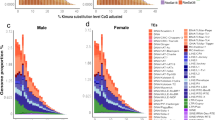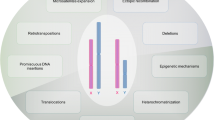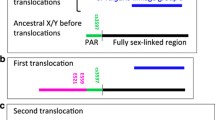Abstract
Sex chromosomes in mammals are about 300 million years old and typically have a highly degenerated Y chromosome. The sex chromosomes in the dioecious plant Silene latifolia in contrast, represent an early stage of evolution in which functional X–Y gene pairs are still frequent. In this study, we characterize a novel tandem repeat called TRAYC, which has accumulated on the Y chromosome in S. latifolia. Its presence demonstrates that processes of satellite accumulation are at work even in this early stage of sex chromosome evolution. The presence of TRAYC in other species of the Elisanthe section suggests that this repeat had spread after the sex chromosomes evolved but before speciation within this section. TRAYC possesses a palindromic character and a strong potential to form secondary structures, which could play a role in satellite evolution. TRAYC accumulation is most prominent near the centromere of the Y chromosome. We propose a role for the centromere as a starting point for the cessation of recombination between the X and Y chromosomes.



Similar content being viewed by others
References
Atanassov I, Delichere C, Filatov DA, Charlesworth D, Negrutiu I, Monéger F (2001) A putative monofunctional fructose-2,6-bisphosphate gene is located on X and Y sex chromosome in white campion (Silene latifolia). Mol Biol Evol 18:2162–2168
Bailey JA, Carrel L, Chakravarti A, Eichler EE (2000) Molecular evidence for a relationship between LINE-1 elements and X chromosome inactivation: the Lyon repeat hypothesis. Proc Natl Acad Sci USA 97:6634–6639
Bechert T, Heck S, Fleig U, Diekmann S, Hegemann JH (1999) All 16 centromere DNAs from Saccharomyces cerevisiae show DNA curvature. Nucleic Acids Res 27:1444–1449
Brodie R, Roper RL, Upton C (2004) JDotter: a Java interface to multiple doplots generated by dotter. Bioinformatics 20:279–281
Buzek J, Koutnikova H, Houben A, Riha K, Janousek B, Siroky J, Grant S, Vyskot B (1997) Isolation and characterization of X chromosome-derived DNA sequences from a dioecious plant Melandrium album. Chromosome Res 5:57–65
Charlesworth B, Sniegowski P, Stephan W (1994) The evolutionary dynamics of repetitive DNA in eukaryotes. Nature 371:215–220
Delichere C, Veskens M, Hernould M, Barbacar N, Mouras A, Negrutiu I, Monéger F (1999) SlY1, the first active gene cloned from a plant Y chromosome encodes a WD-repeat protein. EMBO J 18:4169–4179
Emerson JJ, Kaessmann H, Betran E, Long M (2004) Extensive gene traffic on the mammalian X chromosome. Science 303:537–540
Ferrer N, Azorin F, Villasante A, Gutierrez C, Abad JP (1995) Centromeric dodeca-satellite DNA sequences form fold-back structures. J Mol Biol 245:8–21
Filatov DA (2005) Evolutionary history of Silene latifolia sex chromosomes revealed by genetic mapping of four genes. Genetics 170:975–979
Guttman DS, Charlesworth D (1998) An X-linked gene with a degenerate Y-linked homologue in a dioecious plant. Nature 393:263–266
Handel MA (2004) The XY body: a specialized meiotic chromatin domain. Exp Cell Res 296:57–63
Haupt W, Fischer TC, Winderl S, Francsz P, Torres-Ruiz RA (2001) The CENTROMERE1 (CEN1) region of Arabidopsis thaliana: architecture and functional impact of chromatin. Plant J 27:285–296
Hladilova R, Siroky J, Vyskot B (1998) A cytospine technique for spreading plant metaphases suitable for immunofluorescence studies. Biotechnic Histochem 73:150–156
Hobza R, Lengerova M, Cernohorska H, Rubes J, Vyskot B (2004) FAST-FISH with laser beam microdissected DOP-PCR probe distinguishes the sex chromosomes of Silene latifolia. Chromosome Res 12:245–250
Jiang J, Birchler JA, Parrott WA, Dawe RK (2003) A molecular view of plant centromeres. Trends Plant Sci 8:570–575
Kejnovsky E, Kubat Z, Hobza R, Lengerova M, Sato S, Tabata S, Fukui K, Matsunaga S, Vyskot B (2006) Accumulation of chloroplast DNA sequences on the Y chromosome of Silene latifolia. Genetica (in press)
Khil PP, Oliver B, Camerini-Otero RD (2004) X for intersection: retrotransposition both on and off the X chromosome is more frequent. Trends Genet 21:3–7
Kubalakova M, Macas J, Dolezel J (1997) Mapping of repeated DNA sequences in plant chromosomes by PRINS and C-PRINS. Theor Appl Genet 94:758–763
Lengerova M, Kejnovsky E, Hobza R, Macas J, Grant SR, Vyskot B (2004) Multicolor FISH mapping of the dioecious model plant, Silene latifolia. Theor Appl Genet 108:1193–1199
Lisnic B, Svetec I-K, Saric H, Nikoloc I, Zgaga Z (2005) Palindrome content of the yeasts Saccharomyces cerevisiae genome. Curr Genet 47:289–297
Liu ZY, Moore PH, Ma H, Ackerman CM, Ragiba M, Yu Q, Pearl HM, Kim MS, Charlton JW, Stiles JI, Zee FT, Paterson AH, Ming R (2004) A primitive Y chromosome in papaya marks incipient sex chromosome evolution. Nature 427:348–352
Moore RC, Kozyreva O, Lebel-Hardenack S, Siroky J, Hobza R, Vyskot B, Grant SR (2003) Genetic and functional analysis of DD44, a sex-linked gene from the dioecious plant Silene latifolia, provides clues to early events in sex chromosome evolution. Genetics 163:321–334
Navajas-Perez R, Schwarzacher T, de la Herran R, Ruiz Rejon C, Ruiz Rejon M, Garrido-Ramos MA (2006) The origin and evolution of the variability in a Y-specific satellite-DNA of Rumex acetosa and its relatives. Gene 368:61–71
Nicolas M, Marais G, Hykelova V, Janousek B, Laporte V, Vyskot B, Mouchiroud D, Charlesworth D, Monéger F (2005) A gradual process of recombination restriction in the evolutionary history of the sex chromosomes in dioecious plants. PLoS Biol 3:47–56
Ohno S (1967) Sex chromosomes and sex-linked genes. Springer, Heidelberg New York Berlin
Rozen S, Skaletsky H, Marszalek JD, Minx PJ, Cordum HS, Wateston RH, Wilson RK, Page D (2003) Abundant gene conversion between arms of palindromes in human and ape Y chromosomes. Nature 423:873–876
Shibata F, Hizume M, Kuroki Y (1999) Chromosome painting of Y chromosomes and isolation of a Y chromosome-specific repetitive sequence in the dioecious plant Rumex acetosa. Chromosoma 108:266–270
Shibata F, Hizume M, Kuroki Y (2000) Differentiation and the polymorphic nature of the Y chromosomes revealed by repetitive sequences in the dioecious plant, Rumex acetosa. Chromosome Res 8:229–236
Skaletsky H, Kuroda-Kawaguchi T, Minx PJ, Cordum HS, Hillier L, Brown LG, Repping S, Pyntikova T et al (2003) The male-specific region of the human Y chromosome is a mosaic of discrete sequence classes. Nature 423:825–837
Staden R (1996) The Staden sequence analysis package. Mol Biotechnol 5:233–241
Thompson JD, Higgins DG, Gibson TJ (1994) CLUSTAL W: improving the sensitivity of progressive multiple sequence alignment through sequence weighting, position-specific gap penalties and weight matrix choice. Nucleic Acids Res 22:4673–4680
Vagera J, Paulikova D, Dolezel J (1994) The development of male and female regenerants by in vitro androgenesis in dioecious plant Melandrium album. Ann Bot 73:455–459
Vyskot B, Hobza R (2004) Gender in plants: sex chromosomes are emerging from the fog. Trends Genet 20:432–438
Westergaard M (1958) The mechanism of sex determination in dioecious flowering plants. Adv Genet 9:217–281
Yang H, McLeese J, Weisbart M, Dionne J-L, Lemaire I, Aubin RA (1993) Simplified high throughput protocol for Northern hybridization. Nucleic Acids Res 21:3337–3338
Zluvova J, Janousek B, Negrutiu I, Vyskot B (2005) Comparison of the X and Y chromosome organization in Silene latifolia. Genetics 170:1431–1434
Zuker M (2003) Mfold web server for nucleic acids folding and hybridization prediction. Nucleic Acids Res 31:3406–3415
Acknowledgements
This research was supported by the Grant Agency of the Czech Republic (grants 521/06/0056 to B.V., and 204/05/2097 to E.K.).
Author information
Authors and Affiliations
Corresponding author
Additional information
Communicated by S. Henikoff
Rights and permissions
About this article
Cite this article
Hobza, R., Lengerova, M., Svoboda, J. et al. An accumulation of tandem DNA repeats on the Y chromosome in Silene latifolia during early stages of sex chromosome evolution. Chromosoma 115, 376–382 (2006). https://doi.org/10.1007/s00412-006-0065-5
Received:
Revised:
Accepted:
Published:
Issue Date:
DOI: https://doi.org/10.1007/s00412-006-0065-5




